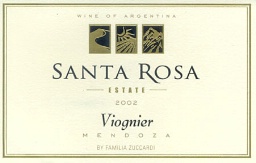
External search
Google (images)
Wine Advocate
Wine Spectator
Burghound
Wine-Searcher
Vintages
2018
2015
2013
2007
2005
2004
2002
From this producer
Show all wines
All tasting notes
|
| Drinking Windows and Values |
| Drinking window: Drink between 2007 and 2008 (based on 1 user opinion) |
| Community Tasting History |
| Community Tasting Notes (average 89 pts. and median of 89 pts. in 1 note) - hiding notes with no text | | | Tasted by andrewstevenson.com on 5/16/2006 & rated 89 points: (tank sample)
This has a lovely sweet, rich nose that is very powerful and concentrated, with some pencil eraser notes. Sweetish attack, which becomes very luscious and velvety on the palate. This is a huge wine with tropical, confected flavours. (1799 views) |
| Familia Zuccardi Producer website
U.S. Importer: THOROUGH info
ZUCCARDI
In 1963, as a way of demonstrating the effectiveness of his irrigation systems, Don Alberto planted the first vineyards in Maipu. Ten years later, he bought a second vineyard site in the desert area of Santa Rosa, a further half an hour to the East of Mendoza city. Under the supervision of Familia Zuccardi’s experienced winemaker, Rodolfo Montenegro, every aspect of production from vineyard to bottle is recorded and monitored at the modern Maipu winery.
Harvest time at the Zuccardis is absolutely magical. With waves of immaculately turned-out harvest staff, bearing the characteristic parral-harvesting breastplate to lay their grapes in, and sun-protective headgear, it is a memorable scene.2005 Familia Zuccardi Viognier Santa Rosa Estate13.5%
Zuccardi were the first company in Argentina to grow viognier: the vineyards in Santa Rosa, Mendoza were planted in 1993 with vines imported from France. The grapes were harvested in the first half of March and the wine was made entirely in stainless steel. 45,000 cases are produced in 2005.ViognierViogner is wrong wine
This is nonsense.Argentina Wines of Argentina
Argentina has been making wine since the 1500s, tracing its wine heritage back to Spain, France and, perhaps surprisingly, Italy. Italian immigration is second only to Spanish in Argentine culture, and the flavors of Italy show up strongly in the nation’s wine, food and cultural tradition. Historically, Argentina has kept much of its wine consumption at home, drinking most of the wine it makes. But we are now seeing more very serious Argentine wines north of the border, and Malbec is leading the movement. The wine-making region in Argentina ranges between the 22° and 42° South latitude. It spreads at the foothills of the Andean mountain range along over 2,400 km; from the province of Salta to the province of Río Negro, with a variety of climates and soils that makes each region a unique land. In general terms, the areas dedicated to vine cultivation are dry and arid with a low level of rain and humidity, determining factor as regards grape health. Abundant sunny days and thermal amplitude favor a good maturity and concentration of aroma and color in the grain. Soils are deep, permeable and poor in organic matter, decisive qualities at the time of obtaining good wine. Due to the low rain regime, irrigation is necessary. Water comes from the Andean range thaw, descending in the shape of rivers to become channels or ditches. Undoubtedly, the combination of these factors turns Argentina into a veritable oasis for the highest quality wine-making. Nevertheless, there is still a long way to go. Wine-making in Argentina, at the level that it achieves today, has a young history that goes back to a little more than 10 years ago. Technological progress, investment and some farsighted businessmen enabled a determining transformation. The province of Mendoza is the most traditional area in the viticultural industry, and is diverse enough to be divided into zones, according to their significantly different weather, height and soil characteristics. These include the Northern Zone, which is suitable for fruity whites and young reds, at a height from 600 to 700m; the Eastern Zone, with a height ranging from 600 to 700m, and the most productive zone in the province; the Uco Valley, a zone of colder weather and higher altitudes (between 800 and 1,400m over sea level); San Rafael, with heights ranging from 450 to 800m; and the High Zone of the Mendoza River, with heights ranging from 800 to 1,100m over sea level and various microclimates, this is the zone where almost all noble varieties have easily become adapted. It is a region that is remarkably well-suited to vine culture, protected from the Pacific’s cooling influence by the Andes and enjoying a long summer of cool nights and warm days, with a dry summer climate but plenty of water available from the region’s rivers. Malbec in particular is outstanding from this area, and it has clearly emerged as the star, the darling of both consumers and critics.Mendoza Wines of Mendoza |
|




